Analysis of Leadership and Management at Toyota Motor Corporation
VerifiedAdded on 2020/11/12
|18
|5471
|336
Report
AI Summary
This report provides a comprehensive analysis of Toyota Motor Corporation's management and operational strategies. It begins with an introduction to Toyota's organizational structure, emphasizing its global and product-based divisions, and then delves into the roles and responsibilities of managers and leaders within the company. The report explores the differences between management and leadership, alongside relevant leadership and management theories such as trait theory, path-goal theory, scientific management, and administrative theory. It examines how managers and leaders navigate various organizational situations, including technological changes, customer complaints, and financial crises, applying situational and systems approaches. Furthermore, the report evaluates the strengths and weaknesses of different leadership and management approaches, offering recommendations for future improvements in operational efficiency and overall organizational effectiveness. The analysis covers key operational areas and the impact of external environmental factors on decision-making, culminating in conclusions and recommendations for Toyota's continued success.
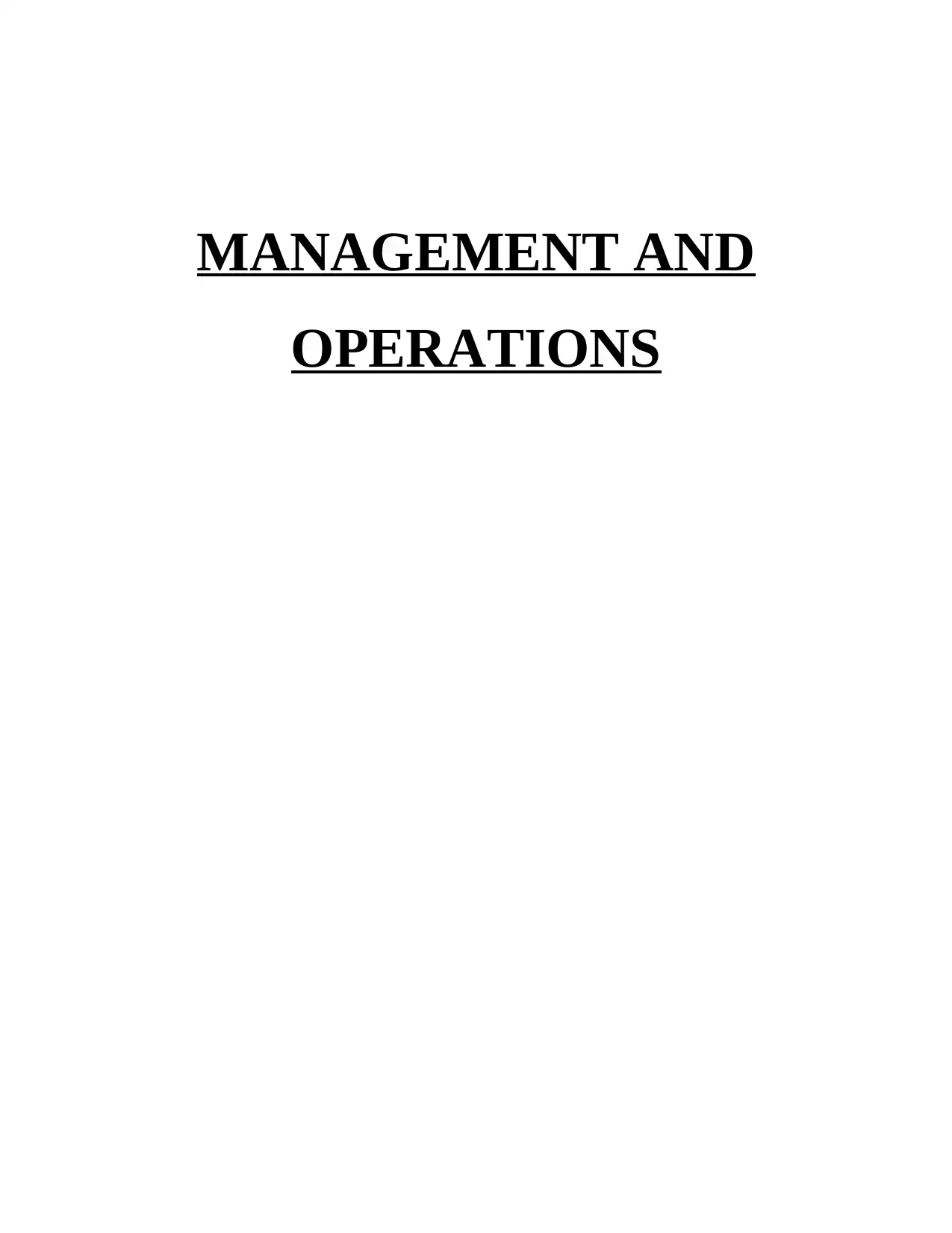
MANAGEMENT AND
OPERATIONS
OPERATIONS
Paraphrase This Document
Need a fresh take? Get an instant paraphrase of this document with our AI Paraphraser
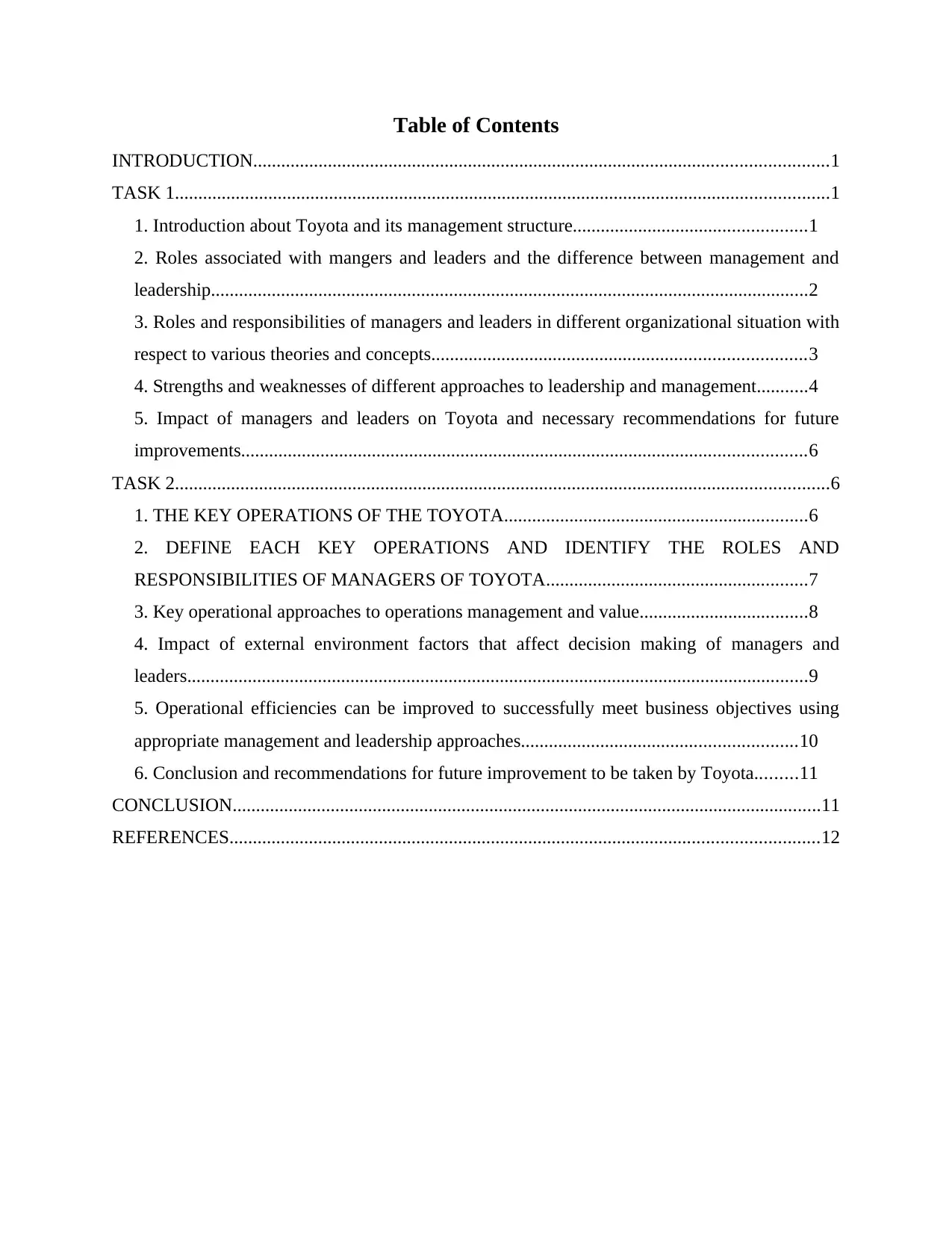
Table of Contents
INTRODUCTION...........................................................................................................................1
TASK 1............................................................................................................................................1
1. Introduction about Toyota and its management structure..................................................1
2. Roles associated with mangers and leaders and the difference between management and
leadership................................................................................................................................2
3. Roles and responsibilities of managers and leaders in different organizational situation with
respect to various theories and concepts................................................................................3
4. Strengths and weaknesses of different approaches to leadership and management...........4
5. Impact of managers and leaders on Toyota and necessary recommendations for future
improvements.........................................................................................................................6
TASK 2............................................................................................................................................6
1. THE KEY OPERATIONS OF THE TOYOTA.................................................................6
2. DEFINE EACH KEY OPERATIONS AND IDENTIFY THE ROLES AND
RESPONSIBILITIES OF MANAGERS OF TOYOTA........................................................7
3. Key operational approaches to operations management and value....................................8
4. Impact of external environment factors that affect decision making of managers and
leaders.....................................................................................................................................9
5. Operational efficiencies can be improved to successfully meet business objectives using
appropriate management and leadership approaches...........................................................10
6. Conclusion and recommendations for future improvement to be taken by Toyota.........11
CONCLUSION..............................................................................................................................11
REFERENCES..............................................................................................................................12
INTRODUCTION...........................................................................................................................1
TASK 1............................................................................................................................................1
1. Introduction about Toyota and its management structure..................................................1
2. Roles associated with mangers and leaders and the difference between management and
leadership................................................................................................................................2
3. Roles and responsibilities of managers and leaders in different organizational situation with
respect to various theories and concepts................................................................................3
4. Strengths and weaknesses of different approaches to leadership and management...........4
5. Impact of managers and leaders on Toyota and necessary recommendations for future
improvements.........................................................................................................................6
TASK 2............................................................................................................................................6
1. THE KEY OPERATIONS OF THE TOYOTA.................................................................6
2. DEFINE EACH KEY OPERATIONS AND IDENTIFY THE ROLES AND
RESPONSIBILITIES OF MANAGERS OF TOYOTA........................................................7
3. Key operational approaches to operations management and value....................................8
4. Impact of external environment factors that affect decision making of managers and
leaders.....................................................................................................................................9
5. Operational efficiencies can be improved to successfully meet business objectives using
appropriate management and leadership approaches...........................................................10
6. Conclusion and recommendations for future improvement to be taken by Toyota.........11
CONCLUSION..............................................................................................................................11
REFERENCES..............................................................................................................................12
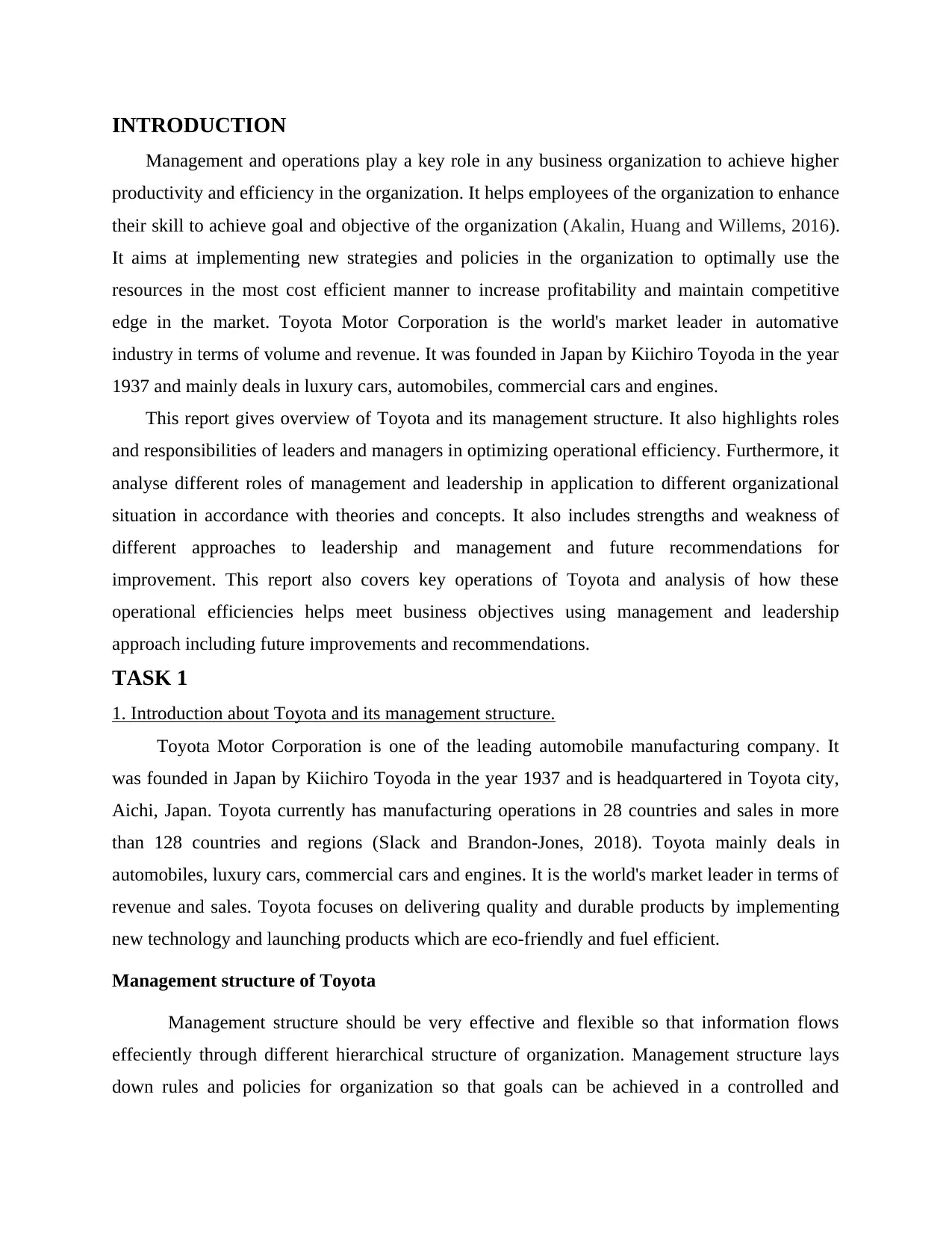
INTRODUCTION
Management and operations play a key role in any business organization to achieve higher
productivity and efficiency in the organization. It helps employees of the organization to enhance
their skill to achieve goal and objective of the organization (Akalin, Huang and Willems, 2016).
It aims at implementing new strategies and policies in the organization to optimally use the
resources in the most cost efficient manner to increase profitability and maintain competitive
edge in the market. Toyota Motor Corporation is the world's market leader in automative
industry in terms of volume and revenue. It was founded in Japan by Kiichiro Toyoda in the year
1937 and mainly deals in luxury cars, automobiles, commercial cars and engines.
This report gives overview of Toyota and its management structure. It also highlights roles
and responsibilities of leaders and managers in optimizing operational efficiency. Furthermore, it
analyse different roles of management and leadership in application to different organizational
situation in accordance with theories and concepts. It also includes strengths and weakness of
different approaches to leadership and management and future recommendations for
improvement. This report also covers key operations of Toyota and analysis of how these
operational efficiencies helps meet business objectives using management and leadership
approach including future improvements and recommendations.
TASK 1
1. Introduction about Toyota and its management structure.
Toyota Motor Corporation is one of the leading automobile manufacturing company. It
was founded in Japan by Kiichiro Toyoda in the year 1937 and is headquartered in Toyota city,
Aichi, Japan. Toyota currently has manufacturing operations in 28 countries and sales in more
than 128 countries and regions (Slack and Brandon-Jones, 2018). Toyota mainly deals in
automobiles, luxury cars, commercial cars and engines. It is the world's market leader in terms of
revenue and sales. Toyota focuses on delivering quality and durable products by implementing
new technology and launching products which are eco-friendly and fuel efficient.
Management structure of Toyota
Management structure should be very effective and flexible so that information flows
effeciently through different hierarchical structure of organization. Management structure lays
down rules and policies for organization so that goals can be achieved in a controlled and
Management and operations play a key role in any business organization to achieve higher
productivity and efficiency in the organization. It helps employees of the organization to enhance
their skill to achieve goal and objective of the organization (Akalin, Huang and Willems, 2016).
It aims at implementing new strategies and policies in the organization to optimally use the
resources in the most cost efficient manner to increase profitability and maintain competitive
edge in the market. Toyota Motor Corporation is the world's market leader in automative
industry in terms of volume and revenue. It was founded in Japan by Kiichiro Toyoda in the year
1937 and mainly deals in luxury cars, automobiles, commercial cars and engines.
This report gives overview of Toyota and its management structure. It also highlights roles
and responsibilities of leaders and managers in optimizing operational efficiency. Furthermore, it
analyse different roles of management and leadership in application to different organizational
situation in accordance with theories and concepts. It also includes strengths and weakness of
different approaches to leadership and management and future recommendations for
improvement. This report also covers key operations of Toyota and analysis of how these
operational efficiencies helps meet business objectives using management and leadership
approach including future improvements and recommendations.
TASK 1
1. Introduction about Toyota and its management structure.
Toyota Motor Corporation is one of the leading automobile manufacturing company. It
was founded in Japan by Kiichiro Toyoda in the year 1937 and is headquartered in Toyota city,
Aichi, Japan. Toyota currently has manufacturing operations in 28 countries and sales in more
than 128 countries and regions (Slack and Brandon-Jones, 2018). Toyota mainly deals in
automobiles, luxury cars, commercial cars and engines. It is the world's market leader in terms of
revenue and sales. Toyota focuses on delivering quality and durable products by implementing
new technology and launching products which are eco-friendly and fuel efficient.
Management structure of Toyota
Management structure should be very effective and flexible so that information flows
effeciently through different hierarchical structure of organization. Management structure lays
down rules and policies for organization so that goals can be achieved in a controlled and
⊘ This is a preview!⊘
Do you want full access?
Subscribe today to unlock all pages.

Trusted by 1+ million students worldwide
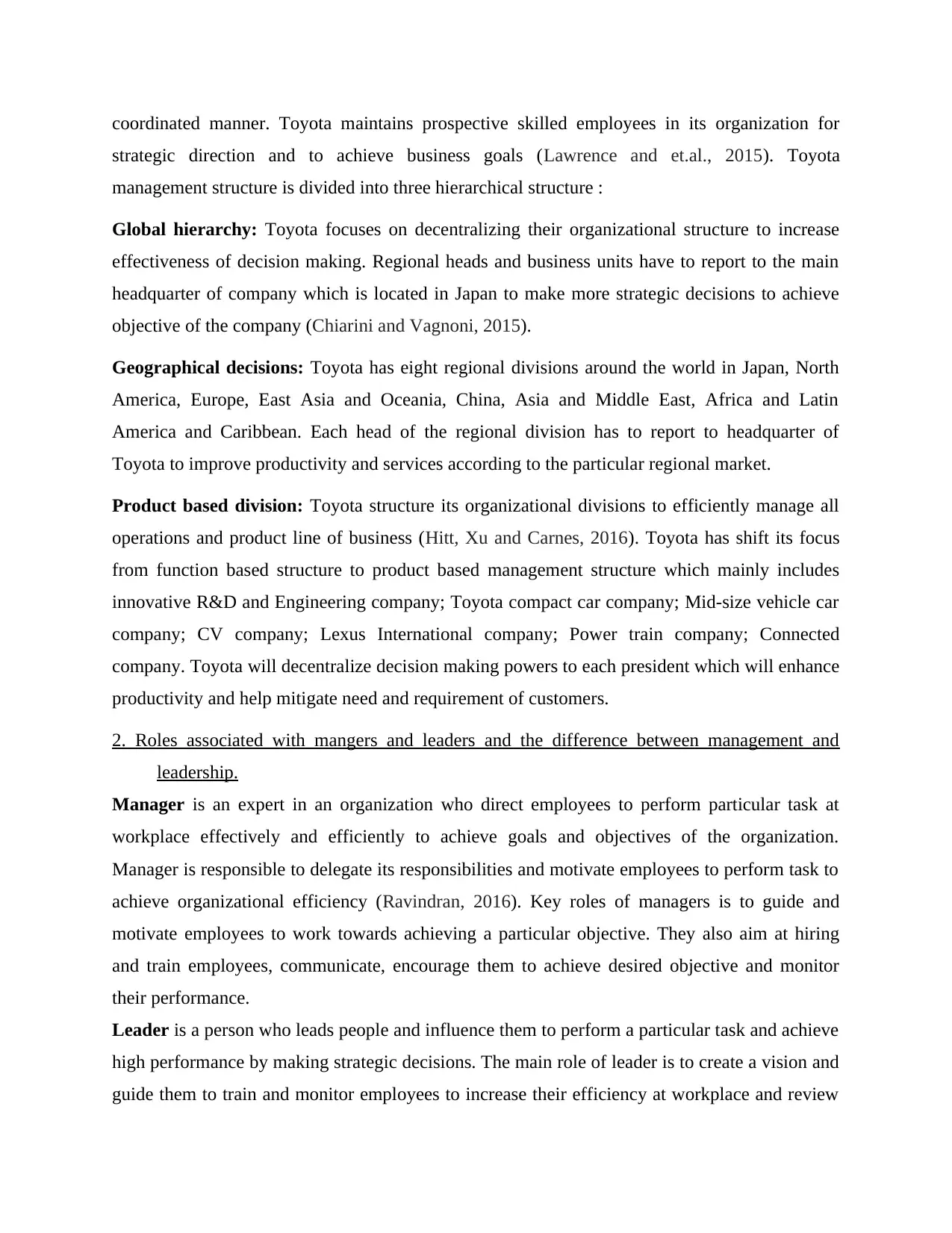
coordinated manner. Toyota maintains prospective skilled employees in its organization for
strategic direction and to achieve business goals (Lawrence and et.al., 2015). Toyota
management structure is divided into three hierarchical structure :
Global hierarchy: Toyota focuses on decentralizing their organizational structure to increase
effectiveness of decision making. Regional heads and business units have to report to the main
headquarter of company which is located in Japan to make more strategic decisions to achieve
objective of the company (Chiarini and Vagnoni, 2015).
Geographical decisions: Toyota has eight regional divisions around the world in Japan, North
America, Europe, East Asia and Oceania, China, Asia and Middle East, Africa and Latin
America and Caribbean. Each head of the regional division has to report to headquarter of
Toyota to improve productivity and services according to the particular regional market.
Product based division: Toyota structure its organizational divisions to efficiently manage all
operations and product line of business (Hitt, Xu and Carnes, 2016). Toyota has shift its focus
from function based structure to product based management structure which mainly includes
innovative R&D and Engineering company; Toyota compact car company; Mid-size vehicle car
company; CV company; Lexus International company; Power train company; Connected
company. Toyota will decentralize decision making powers to each president which will enhance
productivity and help mitigate need and requirement of customers.
2. Roles associated with mangers and leaders and the difference between management and
leadership.
Manager is an expert in an organization who direct employees to perform particular task at
workplace effectively and efficiently to achieve goals and objectives of the organization.
Manager is responsible to delegate its responsibilities and motivate employees to perform task to
achieve organizational efficiency (Ravindran, 2016). Key roles of managers is to guide and
motivate employees to work towards achieving a particular objective. They also aim at hiring
and train employees, communicate, encourage them to achieve desired objective and monitor
their performance.
Leader is a person who leads people and influence them to perform a particular task and achieve
high performance by making strategic decisions. The main role of leader is to create a vision and
guide them to train and monitor employees to increase their efficiency at workplace and review
strategic direction and to achieve business goals (Lawrence and et.al., 2015). Toyota
management structure is divided into three hierarchical structure :
Global hierarchy: Toyota focuses on decentralizing their organizational structure to increase
effectiveness of decision making. Regional heads and business units have to report to the main
headquarter of company which is located in Japan to make more strategic decisions to achieve
objective of the company (Chiarini and Vagnoni, 2015).
Geographical decisions: Toyota has eight regional divisions around the world in Japan, North
America, Europe, East Asia and Oceania, China, Asia and Middle East, Africa and Latin
America and Caribbean. Each head of the regional division has to report to headquarter of
Toyota to improve productivity and services according to the particular regional market.
Product based division: Toyota structure its organizational divisions to efficiently manage all
operations and product line of business (Hitt, Xu and Carnes, 2016). Toyota has shift its focus
from function based structure to product based management structure which mainly includes
innovative R&D and Engineering company; Toyota compact car company; Mid-size vehicle car
company; CV company; Lexus International company; Power train company; Connected
company. Toyota will decentralize decision making powers to each president which will enhance
productivity and help mitigate need and requirement of customers.
2. Roles associated with mangers and leaders and the difference between management and
leadership.
Manager is an expert in an organization who direct employees to perform particular task at
workplace effectively and efficiently to achieve goals and objectives of the organization.
Manager is responsible to delegate its responsibilities and motivate employees to perform task to
achieve organizational efficiency (Ravindran, 2016). Key roles of managers is to guide and
motivate employees to work towards achieving a particular objective. They also aim at hiring
and train employees, communicate, encourage them to achieve desired objective and monitor
their performance.
Leader is a person who leads people and influence them to perform a particular task and achieve
high performance by making strategic decisions. The main role of leader is to create a vision and
guide them to train and monitor employees to increase their efficiency at workplace and review
Paraphrase This Document
Need a fresh take? Get an instant paraphrase of this document with our AI Paraphraser
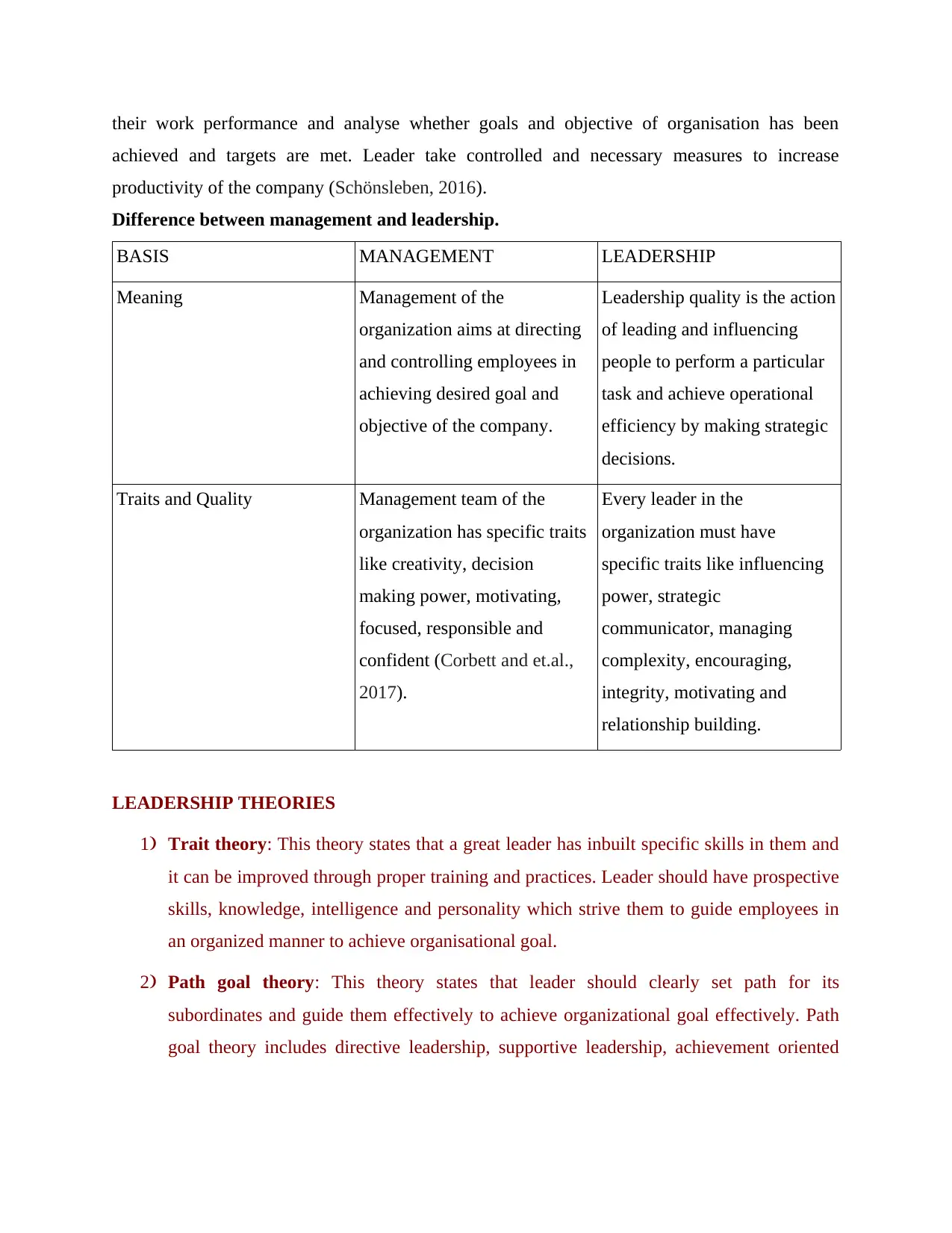
their work performance and analyse whether goals and objective of organisation has been
achieved and targets are met. Leader take controlled and necessary measures to increase
productivity of the company (Schönsleben, 2016).
Difference between management and leadership.
BASIS MANAGEMENT LEADERSHIP
Meaning Management of the
organization aims at directing
and controlling employees in
achieving desired goal and
objective of the company.
Leadership quality is the action
of leading and influencing
people to perform a particular
task and achieve operational
efficiency by making strategic
decisions.
Traits and Quality Management team of the
organization has specific traits
like creativity, decision
making power, motivating,
focused, responsible and
confident (Corbett and et.al.,
2017).
Every leader in the
organization must have
specific traits like influencing
power, strategic
communicator, managing
complexity, encouraging,
integrity, motivating and
relationship building.
LEADERSHIP THEORIES
1) Trait theory: This theory states that a great leader has inbuilt specific skills in them and
it can be improved through proper training and practices. Leader should have prospective
skills, knowledge, intelligence and personality which strive them to guide employees in
an organized manner to achieve organisational goal.
2) Path goal theory: This theory states that leader should clearly set path for its
subordinates and guide them effectively to achieve organizational goal effectively. Path
goal theory includes directive leadership, supportive leadership, achievement oriented
achieved and targets are met. Leader take controlled and necessary measures to increase
productivity of the company (Schönsleben, 2016).
Difference between management and leadership.
BASIS MANAGEMENT LEADERSHIP
Meaning Management of the
organization aims at directing
and controlling employees in
achieving desired goal and
objective of the company.
Leadership quality is the action
of leading and influencing
people to perform a particular
task and achieve operational
efficiency by making strategic
decisions.
Traits and Quality Management team of the
organization has specific traits
like creativity, decision
making power, motivating,
focused, responsible and
confident (Corbett and et.al.,
2017).
Every leader in the
organization must have
specific traits like influencing
power, strategic
communicator, managing
complexity, encouraging,
integrity, motivating and
relationship building.
LEADERSHIP THEORIES
1) Trait theory: This theory states that a great leader has inbuilt specific skills in them and
it can be improved through proper training and practices. Leader should have prospective
skills, knowledge, intelligence and personality which strive them to guide employees in
an organized manner to achieve organisational goal.
2) Path goal theory: This theory states that leader should clearly set path for its
subordinates and guide them effectively to achieve organizational goal effectively. Path
goal theory includes directive leadership, supportive leadership, achievement oriented
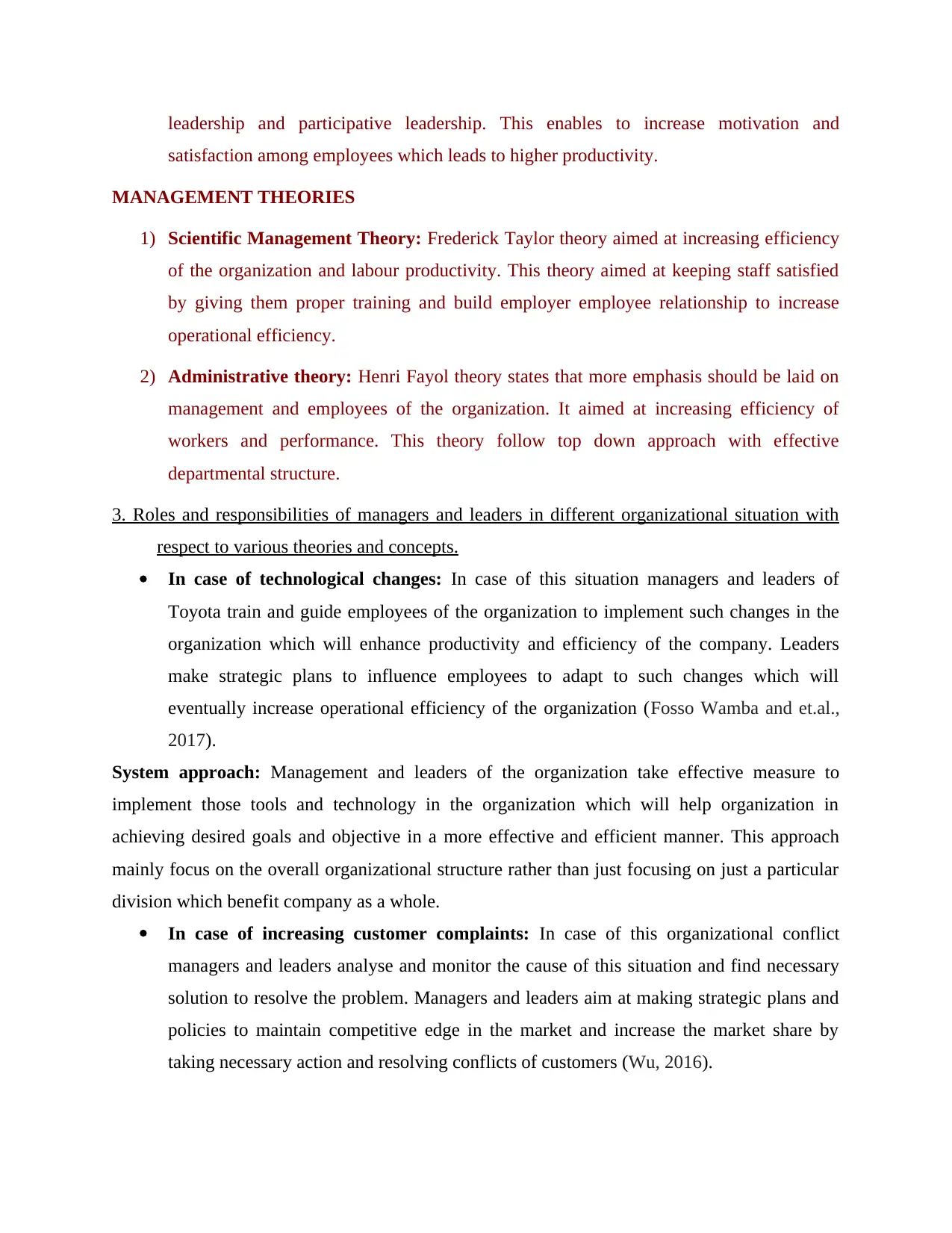
leadership and participative leadership. This enables to increase motivation and
satisfaction among employees which leads to higher productivity.
MANAGEMENT THEORIES
1) Scientific Management Theory: Frederick Taylor theory aimed at increasing efficiency
of the organization and labour productivity. This theory aimed at keeping staff satisfied
by giving them proper training and build employer employee relationship to increase
operational efficiency.
2) Administrative theory: Henri Fayol theory states that more emphasis should be laid on
management and employees of the organization. It aimed at increasing efficiency of
workers and performance. This theory follow top down approach with effective
departmental structure.
3. Roles and responsibilities of managers and leaders in different organizational situation with
respect to various theories and concepts.
In case of technological changes: In case of this situation managers and leaders of
Toyota train and guide employees of the organization to implement such changes in the
organization which will enhance productivity and efficiency of the company. Leaders
make strategic plans to influence employees to adapt to such changes which will
eventually increase operational efficiency of the organization (Fosso Wamba and et.al.,
2017).
System approach: Management and leaders of the organization take effective measure to
implement those tools and technology in the organization which will help organization in
achieving desired goals and objective in a more effective and efficient manner. This approach
mainly focus on the overall organizational structure rather than just focusing on just a particular
division which benefit company as a whole.
In case of increasing customer complaints: In case of this organizational conflict
managers and leaders analyse and monitor the cause of this situation and find necessary
solution to resolve the problem. Managers and leaders aim at making strategic plans and
policies to maintain competitive edge in the market and increase the market share by
taking necessary action and resolving conflicts of customers (Wu, 2016).
satisfaction among employees which leads to higher productivity.
MANAGEMENT THEORIES
1) Scientific Management Theory: Frederick Taylor theory aimed at increasing efficiency
of the organization and labour productivity. This theory aimed at keeping staff satisfied
by giving them proper training and build employer employee relationship to increase
operational efficiency.
2) Administrative theory: Henri Fayol theory states that more emphasis should be laid on
management and employees of the organization. It aimed at increasing efficiency of
workers and performance. This theory follow top down approach with effective
departmental structure.
3. Roles and responsibilities of managers and leaders in different organizational situation with
respect to various theories and concepts.
In case of technological changes: In case of this situation managers and leaders of
Toyota train and guide employees of the organization to implement such changes in the
organization which will enhance productivity and efficiency of the company. Leaders
make strategic plans to influence employees to adapt to such changes which will
eventually increase operational efficiency of the organization (Fosso Wamba and et.al.,
2017).
System approach: Management and leaders of the organization take effective measure to
implement those tools and technology in the organization which will help organization in
achieving desired goals and objective in a more effective and efficient manner. This approach
mainly focus on the overall organizational structure rather than just focusing on just a particular
division which benefit company as a whole.
In case of increasing customer complaints: In case of this organizational conflict
managers and leaders analyse and monitor the cause of this situation and find necessary
solution to resolve the problem. Managers and leaders aim at making strategic plans and
policies to maintain competitive edge in the market and increase the market share by
taking necessary action and resolving conflicts of customers (Wu, 2016).
⊘ This is a preview!⊘
Do you want full access?
Subscribe today to unlock all pages.

Trusted by 1+ million students worldwide
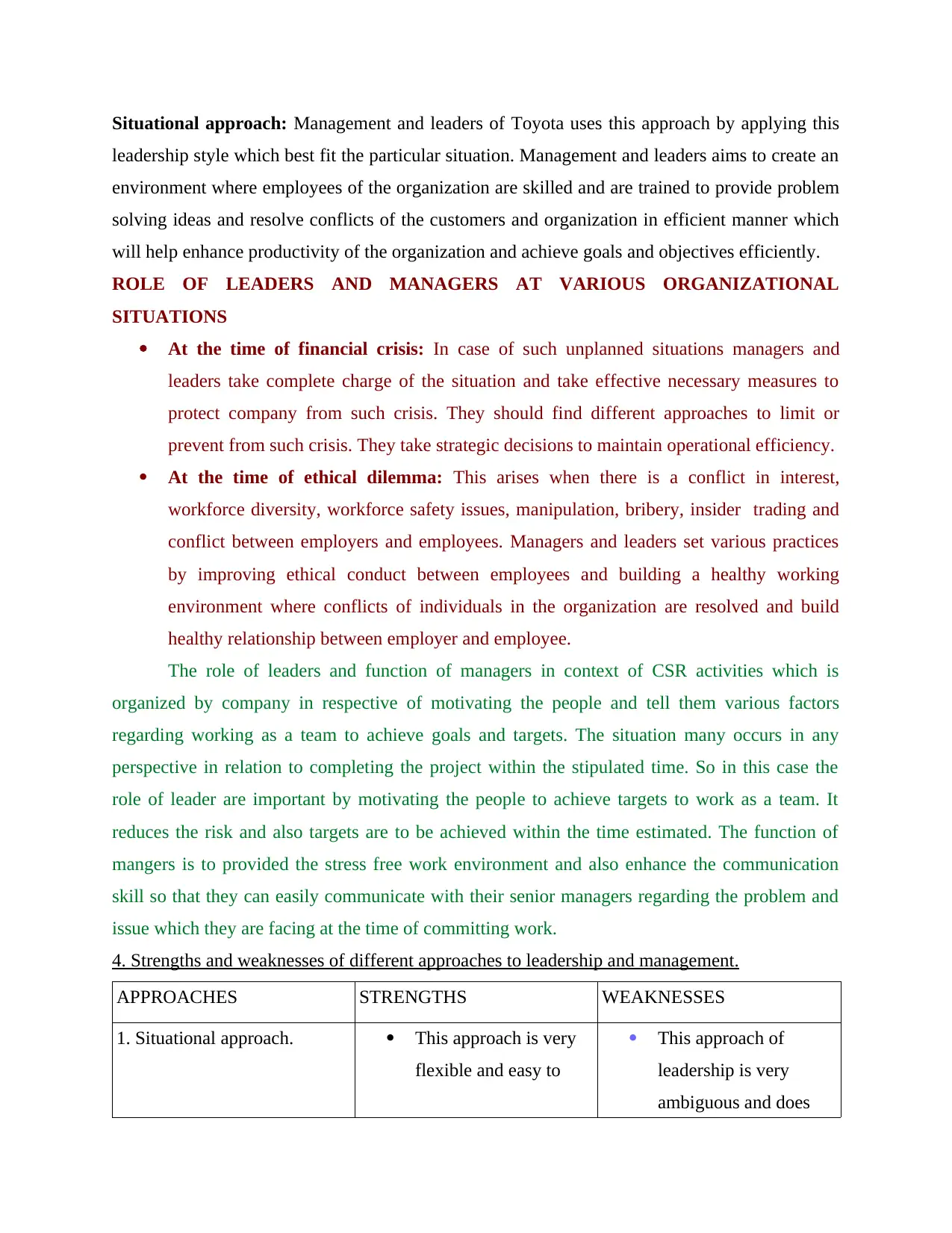
Situational approach: Management and leaders of Toyota uses this approach by applying this
leadership style which best fit the particular situation. Management and leaders aims to create an
environment where employees of the organization are skilled and are trained to provide problem
solving ideas and resolve conflicts of the customers and organization in efficient manner which
will help enhance productivity of the organization and achieve goals and objectives efficiently.
ROLE OF LEADERS AND MANAGERS AT VARIOUS ORGANIZATIONAL
SITUATIONS
At the time of financial crisis: In case of such unplanned situations managers and
leaders take complete charge of the situation and take effective necessary measures to
protect company from such crisis. They should find different approaches to limit or
prevent from such crisis. They take strategic decisions to maintain operational efficiency.
At the time of ethical dilemma: This arises when there is a conflict in interest,
workforce diversity, workforce safety issues, manipulation, bribery, insider trading and
conflict between employers and employees. Managers and leaders set various practices
by improving ethical conduct between employees and building a healthy working
environment where conflicts of individuals in the organization are resolved and build
healthy relationship between employer and employee.
The role of leaders and function of managers in context of CSR activities which is
organized by company in respective of motivating the people and tell them various factors
regarding working as a team to achieve goals and targets. The situation many occurs in any
perspective in relation to completing the project within the stipulated time. So in this case the
role of leader are important by motivating the people to achieve targets to work as a team. It
reduces the risk and also targets are to be achieved within the time estimated. The function of
mangers is to provided the stress free work environment and also enhance the communication
skill so that they can easily communicate with their senior managers regarding the problem and
issue which they are facing at the time of committing work.
4. Strengths and weaknesses of different approaches to leadership and management.
APPROACHES STRENGTHS WEAKNESSES
1. Situational approach. This approach is very
flexible and easy to
This approach of
leadership is very
ambiguous and does
leadership style which best fit the particular situation. Management and leaders aims to create an
environment where employees of the organization are skilled and are trained to provide problem
solving ideas and resolve conflicts of the customers and organization in efficient manner which
will help enhance productivity of the organization and achieve goals and objectives efficiently.
ROLE OF LEADERS AND MANAGERS AT VARIOUS ORGANIZATIONAL
SITUATIONS
At the time of financial crisis: In case of such unplanned situations managers and
leaders take complete charge of the situation and take effective necessary measures to
protect company from such crisis. They should find different approaches to limit or
prevent from such crisis. They take strategic decisions to maintain operational efficiency.
At the time of ethical dilemma: This arises when there is a conflict in interest,
workforce diversity, workforce safety issues, manipulation, bribery, insider trading and
conflict between employers and employees. Managers and leaders set various practices
by improving ethical conduct between employees and building a healthy working
environment where conflicts of individuals in the organization are resolved and build
healthy relationship between employer and employee.
The role of leaders and function of managers in context of CSR activities which is
organized by company in respective of motivating the people and tell them various factors
regarding working as a team to achieve goals and targets. The situation many occurs in any
perspective in relation to completing the project within the stipulated time. So in this case the
role of leader are important by motivating the people to achieve targets to work as a team. It
reduces the risk and also targets are to be achieved within the time estimated. The function of
mangers is to provided the stress free work environment and also enhance the communication
skill so that they can easily communicate with their senior managers regarding the problem and
issue which they are facing at the time of committing work.
4. Strengths and weaknesses of different approaches to leadership and management.
APPROACHES STRENGTHS WEAKNESSES
1. Situational approach. This approach is very
flexible and easy to
This approach of
leadership is very
ambiguous and does
Paraphrase This Document
Need a fresh take? Get an instant paraphrase of this document with our AI Paraphraser
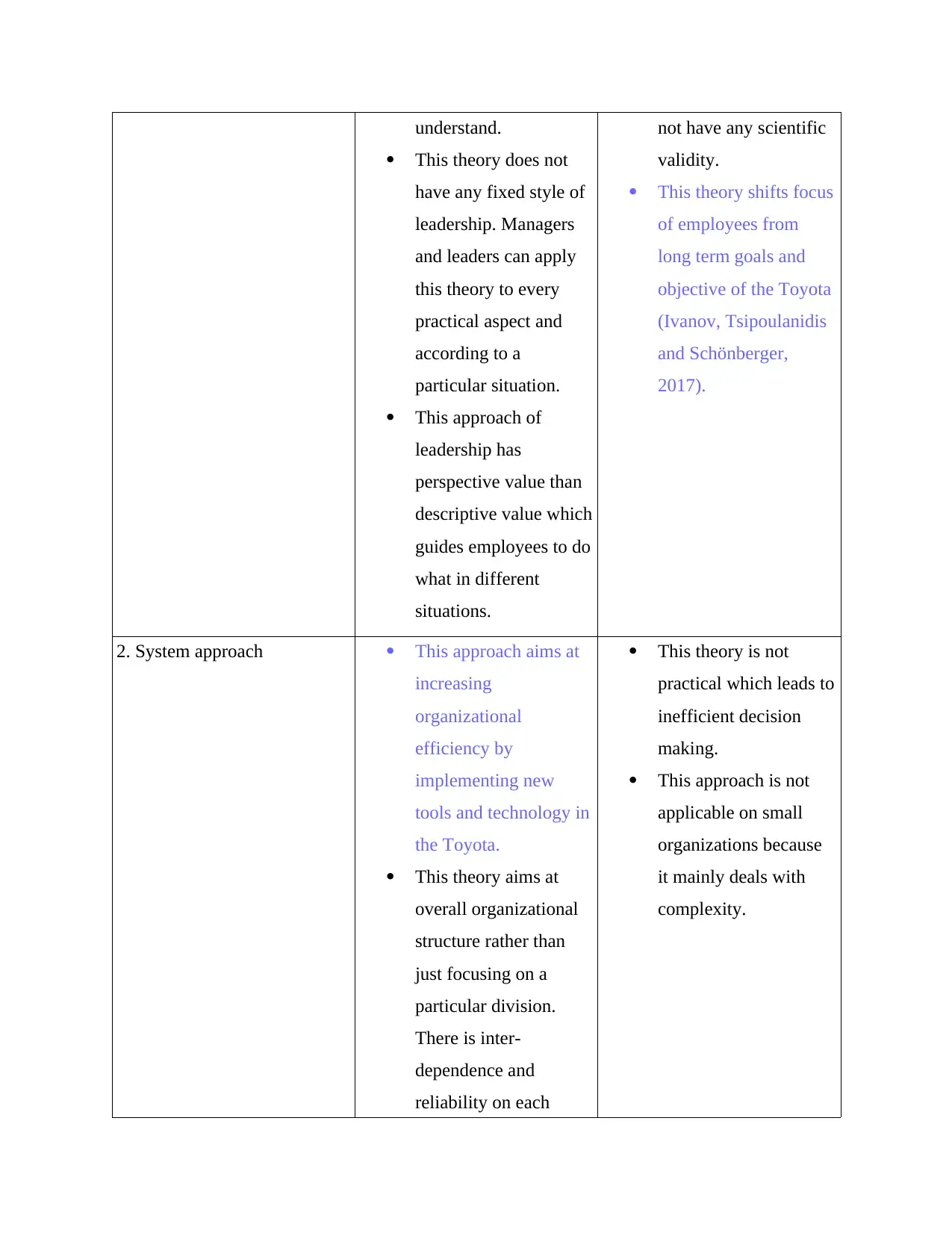
understand.
This theory does not
have any fixed style of
leadership. Managers
and leaders can apply
this theory to every
practical aspect and
according to a
particular situation.
This approach of
leadership has
perspective value than
descriptive value which
guides employees to do
what in different
situations.
not have any scientific
validity.
This theory shifts focus
of employees from
long term goals and
objective of the Toyota
(Ivanov, Tsipoulanidis
and Schönberger,
2017).
2. System approach This approach aims at
increasing
organizational
efficiency by
implementing new
tools and technology in
the Toyota.
This theory aims at
overall organizational
structure rather than
just focusing on a
particular division.
There is inter-
dependence and
reliability on each
This theory is not
practical which leads to
inefficient decision
making.
This approach is not
applicable on small
organizations because
it mainly deals with
complexity.
This theory does not
have any fixed style of
leadership. Managers
and leaders can apply
this theory to every
practical aspect and
according to a
particular situation.
This approach of
leadership has
perspective value than
descriptive value which
guides employees to do
what in different
situations.
not have any scientific
validity.
This theory shifts focus
of employees from
long term goals and
objective of the Toyota
(Ivanov, Tsipoulanidis
and Schönberger,
2017).
2. System approach This approach aims at
increasing
organizational
efficiency by
implementing new
tools and technology in
the Toyota.
This theory aims at
overall organizational
structure rather than
just focusing on a
particular division.
There is inter-
dependence and
reliability on each
This theory is not
practical which leads to
inefficient decision
making.
This approach is not
applicable on small
organizations because
it mainly deals with
complexity.
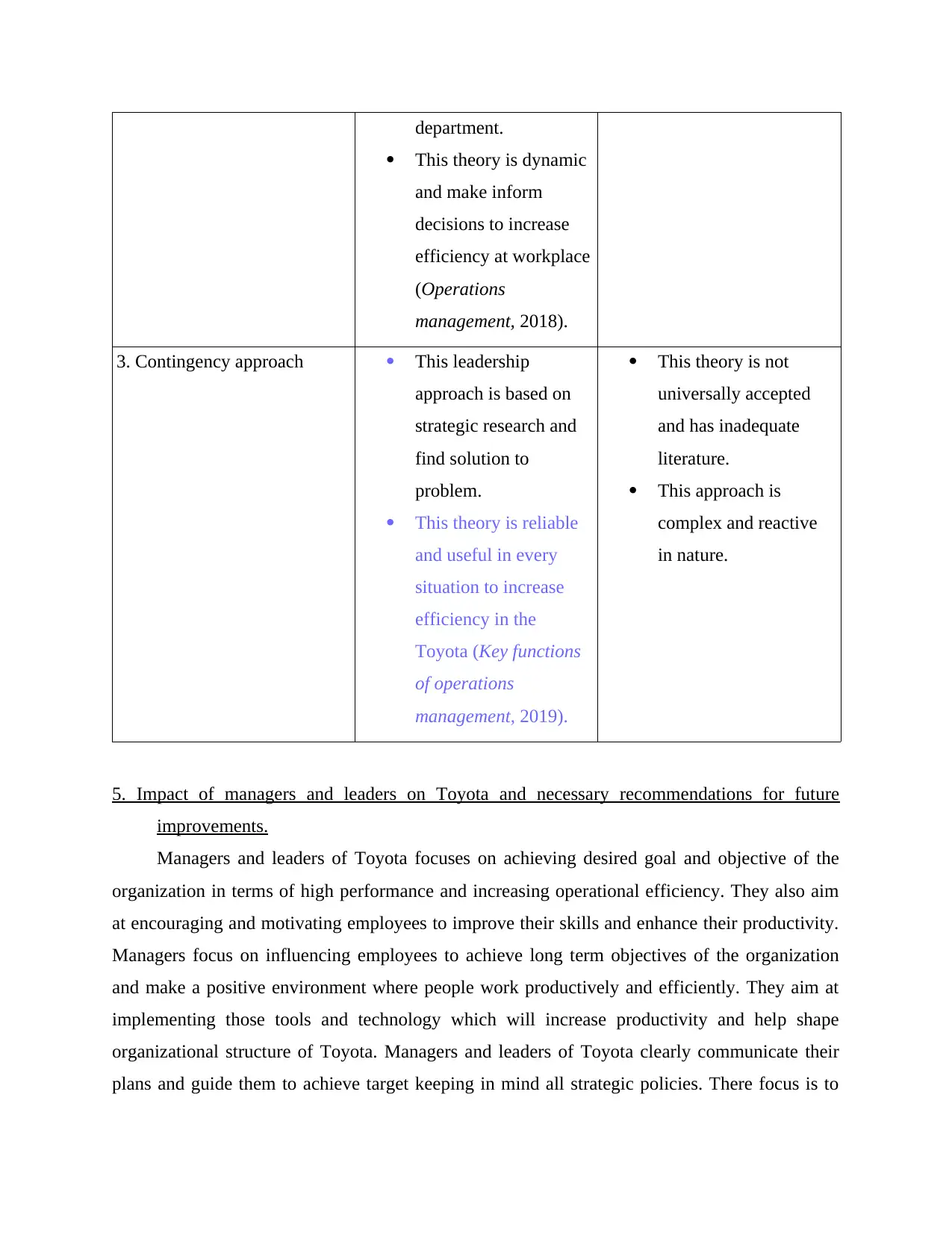
department.
This theory is dynamic
and make inform
decisions to increase
efficiency at workplace
(Operations
management, 2018).
3. Contingency approach This leadership
approach is based on
strategic research and
find solution to
problem.
This theory is reliable
and useful in every
situation to increase
efficiency in the
Toyota (Key functions
of operations
management, 2019).
This theory is not
universally accepted
and has inadequate
literature.
This approach is
complex and reactive
in nature.
5. Impact of managers and leaders on Toyota and necessary recommendations for future
improvements.
Managers and leaders of Toyota focuses on achieving desired goal and objective of the
organization in terms of high performance and increasing operational efficiency. They also aim
at encouraging and motivating employees to improve their skills and enhance their productivity.
Managers focus on influencing employees to achieve long term objectives of the organization
and make a positive environment where people work productively and efficiently. They aim at
implementing those tools and technology which will increase productivity and help shape
organizational structure of Toyota. Managers and leaders of Toyota clearly communicate their
plans and guide them to achieve target keeping in mind all strategic policies. There focus is to
This theory is dynamic
and make inform
decisions to increase
efficiency at workplace
(Operations
management, 2018).
3. Contingency approach This leadership
approach is based on
strategic research and
find solution to
problem.
This theory is reliable
and useful in every
situation to increase
efficiency in the
Toyota (Key functions
of operations
management, 2019).
This theory is not
universally accepted
and has inadequate
literature.
This approach is
complex and reactive
in nature.
5. Impact of managers and leaders on Toyota and necessary recommendations for future
improvements.
Managers and leaders of Toyota focuses on achieving desired goal and objective of the
organization in terms of high performance and increasing operational efficiency. They also aim
at encouraging and motivating employees to improve their skills and enhance their productivity.
Managers focus on influencing employees to achieve long term objectives of the organization
and make a positive environment where people work productively and efficiently. They aim at
implementing those tools and technology which will increase productivity and help shape
organizational structure of Toyota. Managers and leaders of Toyota clearly communicate their
plans and guide them to achieve target keeping in mind all strategic policies. There focus is to
⊘ This is a preview!⊘
Do you want full access?
Subscribe today to unlock all pages.

Trusted by 1+ million students worldwide
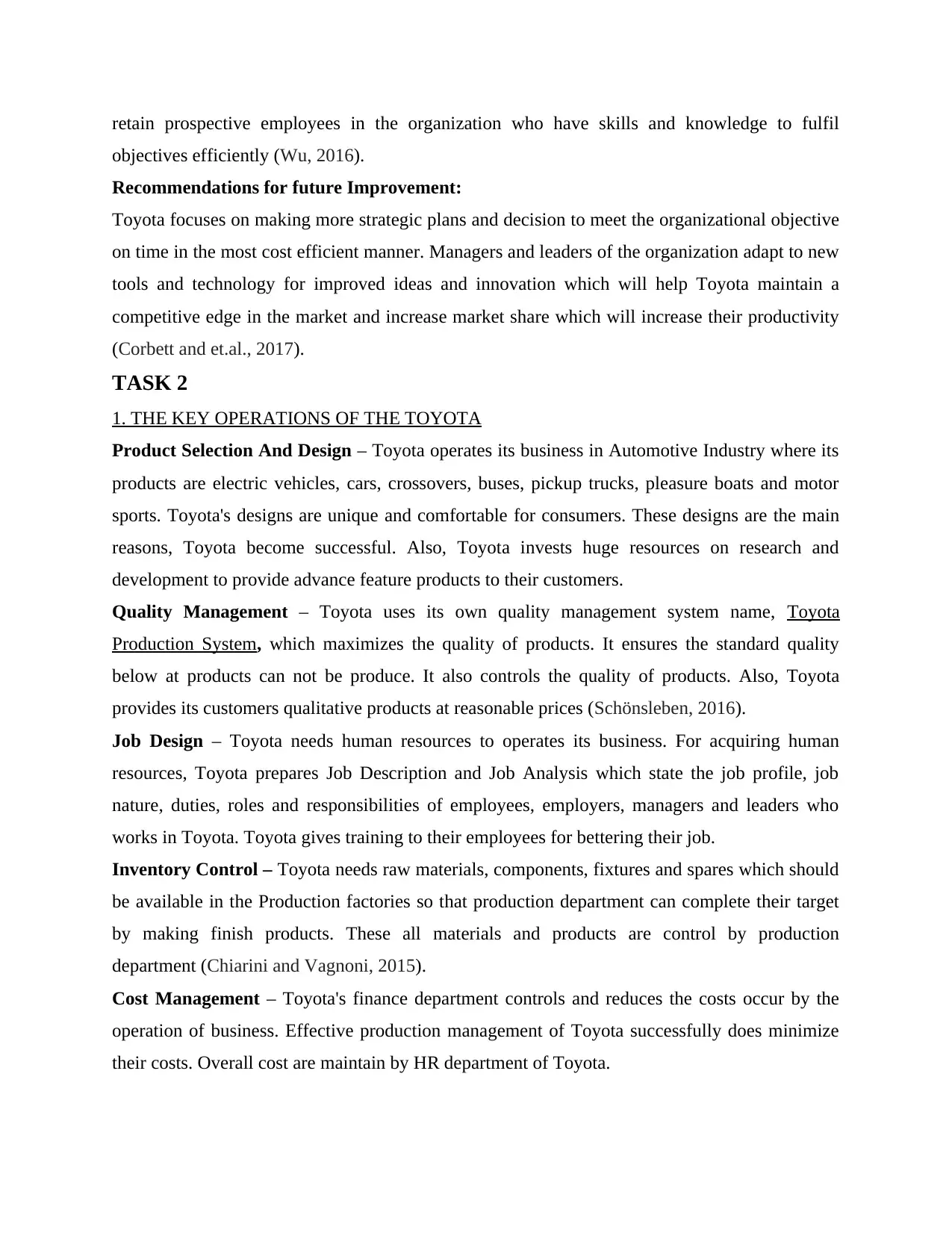
retain prospective employees in the organization who have skills and knowledge to fulfil
objectives efficiently (Wu, 2016).
Recommendations for future Improvement:
Toyota focuses on making more strategic plans and decision to meet the organizational objective
on time in the most cost efficient manner. Managers and leaders of the organization adapt to new
tools and technology for improved ideas and innovation which will help Toyota maintain a
competitive edge in the market and increase market share which will increase their productivity
(Corbett and et.al., 2017).
TASK 2
1. THE KEY OPERATIONS OF THE TOYOTA
Product Selection And Design – Toyota operates its business in Automotive Industry where its
products are electric vehicles, cars, crossovers, buses, pickup trucks, pleasure boats and motor
sports. Toyota's designs are unique and comfortable for consumers. These designs are the main
reasons, Toyota become successful. Also, Toyota invests huge resources on research and
development to provide advance feature products to their customers.
Quality Management – Toyota uses its own quality management system name, Toyota
Production System, which maximizes the quality of products. It ensures the standard quality
below at products can not be produce. It also controls the quality of products. Also, Toyota
provides its customers qualitative products at reasonable prices (Schönsleben, 2016).
Job Design – Toyota needs human resources to operates its business. For acquiring human
resources, Toyota prepares Job Description and Job Analysis which state the job profile, job
nature, duties, roles and responsibilities of employees, employers, managers and leaders who
works in Toyota. Toyota gives training to their employees for bettering their job.
Inventory Control – Toyota needs raw materials, components, fixtures and spares which should
be available in the Production factories so that production department can complete their target
by making finish products. These all materials and products are control by production
department (Chiarini and Vagnoni, 2015).
Cost Management – Toyota's finance department controls and reduces the costs occur by the
operation of business. Effective production management of Toyota successfully does minimize
their costs. Overall cost are maintain by HR department of Toyota.
objectives efficiently (Wu, 2016).
Recommendations for future Improvement:
Toyota focuses on making more strategic plans and decision to meet the organizational objective
on time in the most cost efficient manner. Managers and leaders of the organization adapt to new
tools and technology for improved ideas and innovation which will help Toyota maintain a
competitive edge in the market and increase market share which will increase their productivity
(Corbett and et.al., 2017).
TASK 2
1. THE KEY OPERATIONS OF THE TOYOTA
Product Selection And Design – Toyota operates its business in Automotive Industry where its
products are electric vehicles, cars, crossovers, buses, pickup trucks, pleasure boats and motor
sports. Toyota's designs are unique and comfortable for consumers. These designs are the main
reasons, Toyota become successful. Also, Toyota invests huge resources on research and
development to provide advance feature products to their customers.
Quality Management – Toyota uses its own quality management system name, Toyota
Production System, which maximizes the quality of products. It ensures the standard quality
below at products can not be produce. It also controls the quality of products. Also, Toyota
provides its customers qualitative products at reasonable prices (Schönsleben, 2016).
Job Design – Toyota needs human resources to operates its business. For acquiring human
resources, Toyota prepares Job Description and Job Analysis which state the job profile, job
nature, duties, roles and responsibilities of employees, employers, managers and leaders who
works in Toyota. Toyota gives training to their employees for bettering their job.
Inventory Control – Toyota needs raw materials, components, fixtures and spares which should
be available in the Production factories so that production department can complete their target
by making finish products. These all materials and products are control by production
department (Chiarini and Vagnoni, 2015).
Cost Management – Toyota's finance department controls and reduces the costs occur by the
operation of business. Effective production management of Toyota successfully does minimize
their costs. Overall cost are maintain by HR department of Toyota.
Paraphrase This Document
Need a fresh take? Get an instant paraphrase of this document with our AI Paraphraser
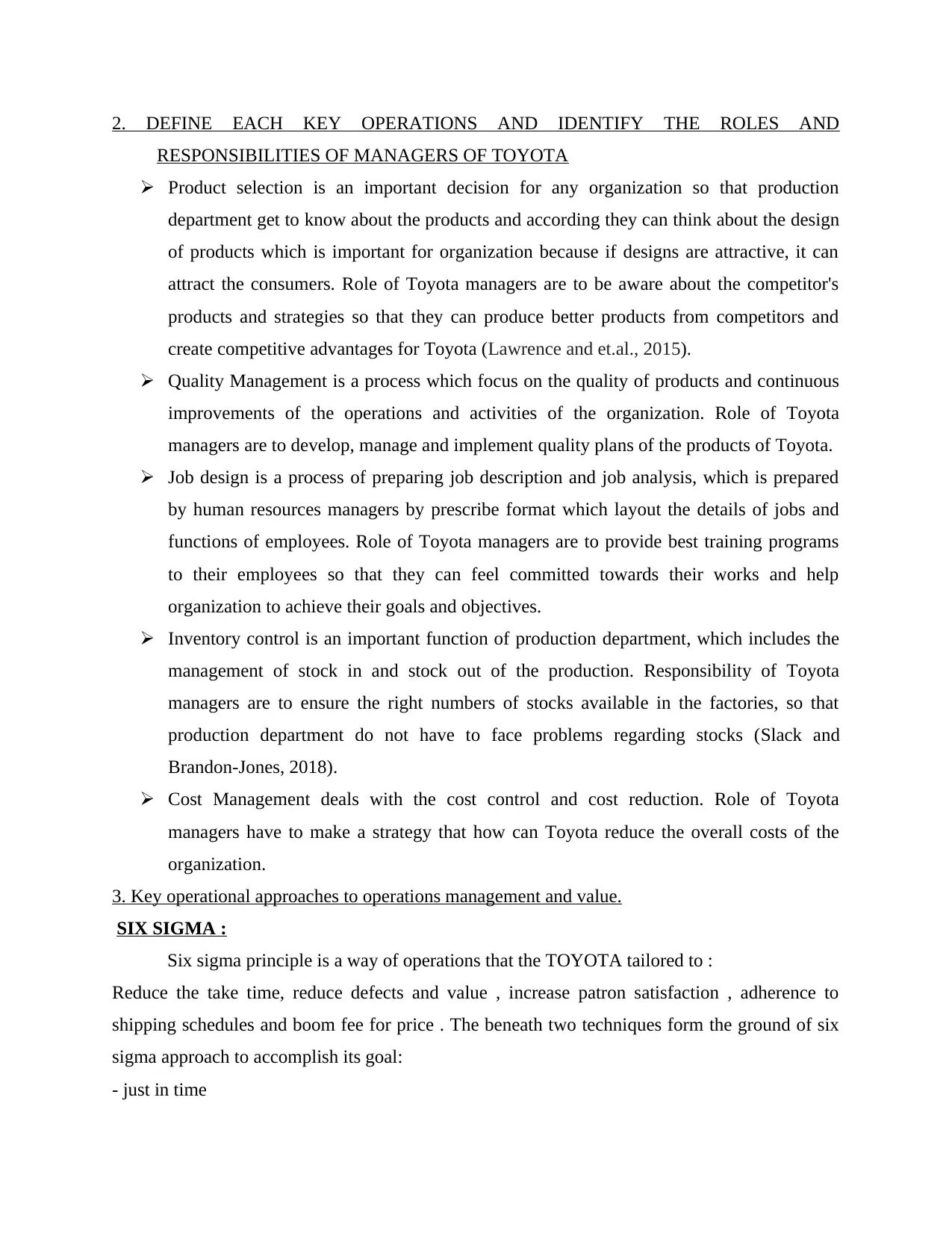
2. DEFINE EACH KEY OPERATIONS AND IDENTIFY THE ROLES AND
RESPONSIBILITIES OF MANAGERS OF TOYOTA
Product selection is an important decision for any organization so that production
department get to know about the products and according they can think about the design
of products which is important for organization because if designs are attractive, it can
attract the consumers. Role of Toyota managers are to be aware about the competitor's
products and strategies so that they can produce better products from competitors and
create competitive advantages for Toyota (Lawrence and et.al., 2015).
Quality Management is a process which focus on the quality of products and continuous
improvements of the operations and activities of the organization. Role of Toyota
managers are to develop, manage and implement quality plans of the products of Toyota.
Job design is a process of preparing job description and job analysis, which is prepared
by human resources managers by prescribe format which layout the details of jobs and
functions of employees. Role of Toyota managers are to provide best training programs
to their employees so that they can feel committed towards their works and help
organization to achieve their goals and objectives.
Inventory control is an important function of production department, which includes the
management of stock in and stock out of the production. Responsibility of Toyota
managers are to ensure the right numbers of stocks available in the factories, so that
production department do not have to face problems regarding stocks (Slack and
Brandon-Jones, 2018).
Cost Management deals with the cost control and cost reduction. Role of Toyota
managers have to make a strategy that how can Toyota reduce the overall costs of the
organization.
3. Key operational approaches to operations management and value.
SIX SIGMA :
Six sigma principle is a way of operations that the TOYOTA tailored to :
Reduce the take time, reduce defects and value , increase patron satisfaction , adherence to
shipping schedules and boom fee for price . The beneath two techniques form the ground of six
sigma approach to accomplish its goal:
- just in time
RESPONSIBILITIES OF MANAGERS OF TOYOTA
Product selection is an important decision for any organization so that production
department get to know about the products and according they can think about the design
of products which is important for organization because if designs are attractive, it can
attract the consumers. Role of Toyota managers are to be aware about the competitor's
products and strategies so that they can produce better products from competitors and
create competitive advantages for Toyota (Lawrence and et.al., 2015).
Quality Management is a process which focus on the quality of products and continuous
improvements of the operations and activities of the organization. Role of Toyota
managers are to develop, manage and implement quality plans of the products of Toyota.
Job design is a process of preparing job description and job analysis, which is prepared
by human resources managers by prescribe format which layout the details of jobs and
functions of employees. Role of Toyota managers are to provide best training programs
to their employees so that they can feel committed towards their works and help
organization to achieve their goals and objectives.
Inventory control is an important function of production department, which includes the
management of stock in and stock out of the production. Responsibility of Toyota
managers are to ensure the right numbers of stocks available in the factories, so that
production department do not have to face problems regarding stocks (Slack and
Brandon-Jones, 2018).
Cost Management deals with the cost control and cost reduction. Role of Toyota
managers have to make a strategy that how can Toyota reduce the overall costs of the
organization.
3. Key operational approaches to operations management and value.
SIX SIGMA :
Six sigma principle is a way of operations that the TOYOTA tailored to :
Reduce the take time, reduce defects and value , increase patron satisfaction , adherence to
shipping schedules and boom fee for price . The beneath two techniques form the ground of six
sigma approach to accomplish its goal:
- just in time
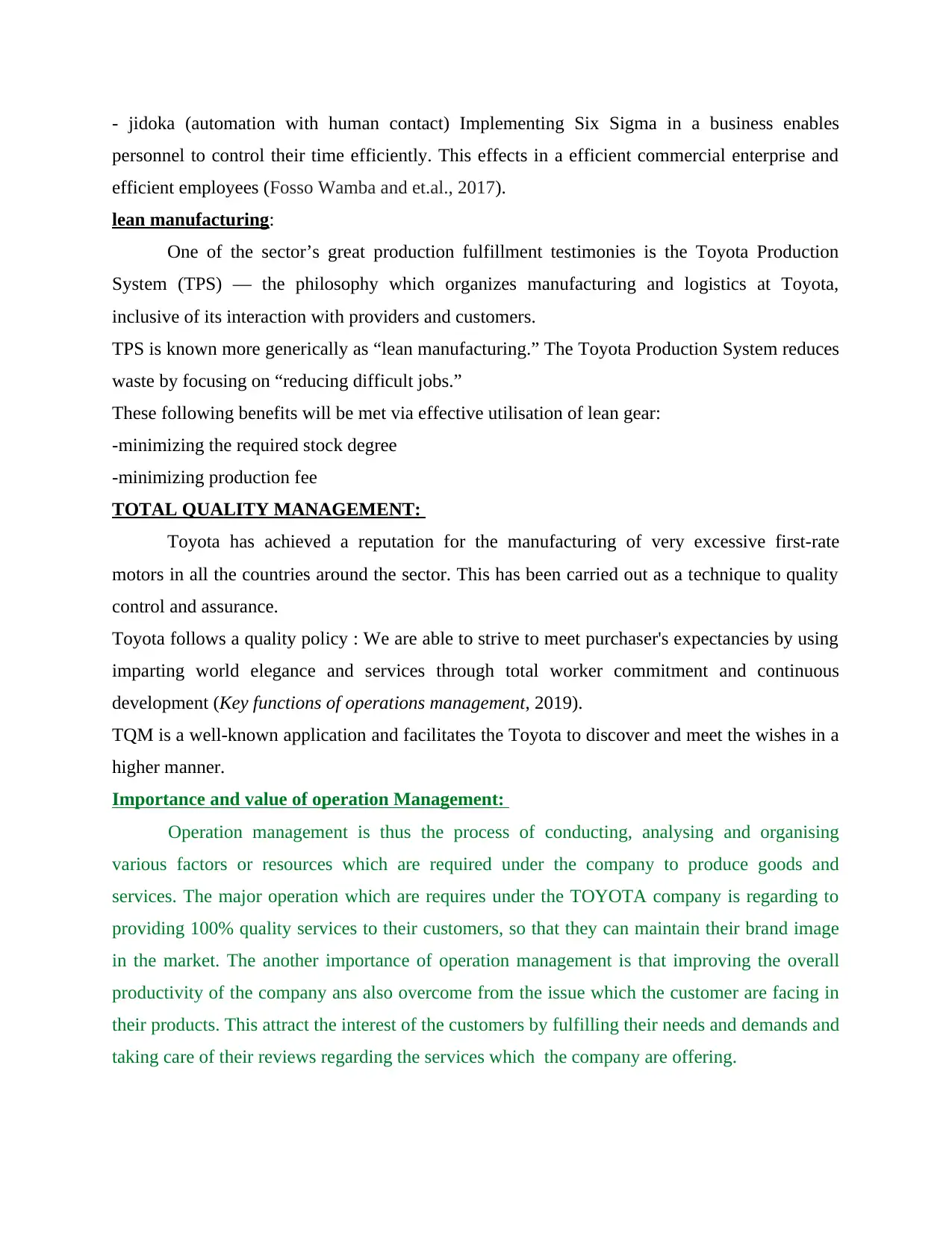
- jidoka (automation with human contact) Implementing Six Sigma in a business enables
personnel to control their time efficiently. This effects in a efficient commercial enterprise and
efficient employees (Fosso Wamba and et.al., 2017).
lean manufacturing:
One of the sector’s great production fulfillment testimonies is the Toyota Production
System (TPS) — the philosophy which organizes manufacturing and logistics at Toyota,
inclusive of its interaction with providers and customers.
TPS is known more generically as “lean manufacturing.” The Toyota Production System reduces
waste by focusing on “reducing difficult jobs.”
These following benefits will be met via effective utilisation of lean gear:
-minimizing the required stock degree
-minimizing production fee
TOTAL QUALITY MANAGEMENT:
Toyota has achieved a reputation for the manufacturing of very excessive first-rate
motors in all the countries around the sector. This has been carried out as a technique to quality
control and assurance.
Toyota follows a quality policy : We are able to strive to meet purchaser's expectancies by using
imparting world elegance and services through total worker commitment and continuous
development (Key functions of operations management, 2019).
TQM is a well-known application and facilitates the Toyota to discover and meet the wishes in a
higher manner.
Importance and value of operation Management:
Operation management is thus the process of conducting, analysing and organising
various factors or resources which are required under the company to produce goods and
services. The major operation which are requires under the TOYOTA company is regarding to
providing 100% quality services to their customers, so that they can maintain their brand image
in the market. The another importance of operation management is that improving the overall
productivity of the company ans also overcome from the issue which the customer are facing in
their products. This attract the interest of the customers by fulfilling their needs and demands and
taking care of their reviews regarding the services which the company are offering.
personnel to control their time efficiently. This effects in a efficient commercial enterprise and
efficient employees (Fosso Wamba and et.al., 2017).
lean manufacturing:
One of the sector’s great production fulfillment testimonies is the Toyota Production
System (TPS) — the philosophy which organizes manufacturing and logistics at Toyota,
inclusive of its interaction with providers and customers.
TPS is known more generically as “lean manufacturing.” The Toyota Production System reduces
waste by focusing on “reducing difficult jobs.”
These following benefits will be met via effective utilisation of lean gear:
-minimizing the required stock degree
-minimizing production fee
TOTAL QUALITY MANAGEMENT:
Toyota has achieved a reputation for the manufacturing of very excessive first-rate
motors in all the countries around the sector. This has been carried out as a technique to quality
control and assurance.
Toyota follows a quality policy : We are able to strive to meet purchaser's expectancies by using
imparting world elegance and services through total worker commitment and continuous
development (Key functions of operations management, 2019).
TQM is a well-known application and facilitates the Toyota to discover and meet the wishes in a
higher manner.
Importance and value of operation Management:
Operation management is thus the process of conducting, analysing and organising
various factors or resources which are required under the company to produce goods and
services. The major operation which are requires under the TOYOTA company is regarding to
providing 100% quality services to their customers, so that they can maintain their brand image
in the market. The another importance of operation management is that improving the overall
productivity of the company ans also overcome from the issue which the customer are facing in
their products. This attract the interest of the customers by fulfilling their needs and demands and
taking care of their reviews regarding the services which the company are offering.
⊘ This is a preview!⊘
Do you want full access?
Subscribe today to unlock all pages.

Trusted by 1+ million students worldwide
1 out of 18
Related Documents
Your All-in-One AI-Powered Toolkit for Academic Success.
+13062052269
info@desklib.com
Available 24*7 on WhatsApp / Email
![[object Object]](/_next/static/media/star-bottom.7253800d.svg)
Unlock your academic potential
Copyright © 2020–2025 A2Z Services. All Rights Reserved. Developed and managed by ZUCOL.




